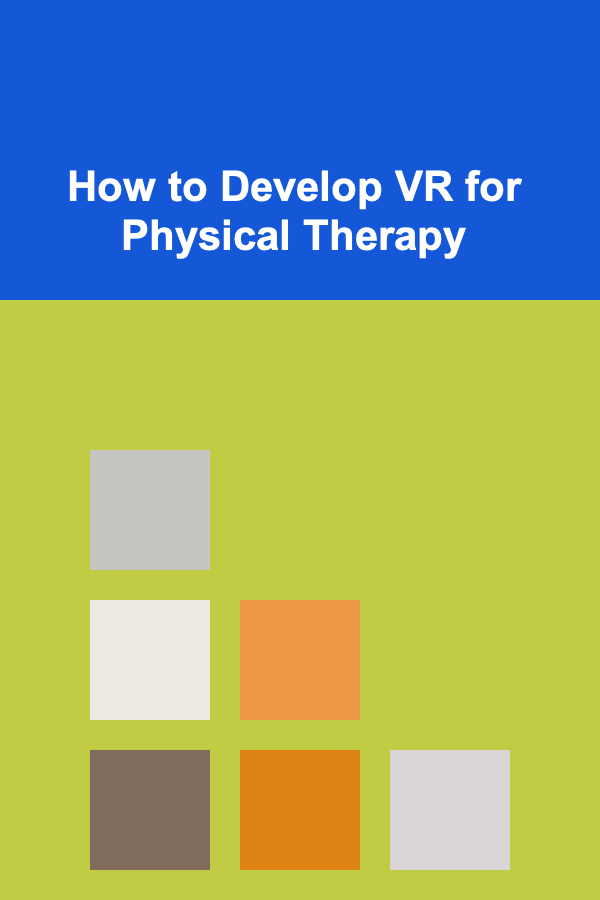
How to Develop VR for Physical Therapy
ebook include PDF & Audio bundle (Micro Guide)
$12.99$8.99
Limited Time Offer! Order within the next:

Virtual Reality (VR) has been rapidly advancing over the past decade, bringing transformative possibilities to various industries. Among the most promising areas where VR is making a significant impact is healthcare, particularly in physical therapy. The application of VR in physical therapy not only offers a new avenue for patient treatment but also provides an immersive experience that can enhance engagement, motivate patients, and facilitate the rehabilitation process. This article will explore how to develop VR for physical therapy, focusing on the critical steps, challenges, and opportunities in integrating VR technology into this field.
The Role of VR in Physical Therapy
Before diving into the specifics of VR development for physical therapy, it is important to understand its role and benefits in rehabilitation. Traditional physical therapy relies on exercises and manual techniques to help patients recover from injuries, surgeries, or physical impairments. While effective, it can be time-consuming, often requires in-person visits, and may sometimes lack patient engagement.
VR has the potential to address these challenges by providing an interactive and immersive environment where patients can perform exercises in a more engaging and motivating way. For example, VR can simulate environments that encourage patients to complete physical tasks (e.g., playing a game that requires them to move their arms or legs), making rehabilitation exercises feel less like a chore. This can lead to improved adherence to therapy plans and better long-term outcomes.
Additionally, VR allows physical therapists to monitor patient progress in real-time, adjusting treatment plans based on performance. With a growing body of evidence supporting the benefits of VR-based physical therapy, the next step is to understand how to develop effective VR solutions.
Key Considerations for Developing VR for Physical Therapy
When developing VR solutions for physical therapy, there are several key considerations that must be taken into account to ensure effectiveness, safety, and usability.
1. Understanding the Target Patient Population
The development of any healthcare-related technology should begin with a deep understanding of the target user group. In the case of physical therapy, this means considering the physical, cognitive, and emotional challenges faced by patients. For instance, patients recovering from strokes may have limited mobility on one side of their body, while patients with musculoskeletal injuries might need exercises that focus on strength or flexibility.
- Physical Abilities: VR applications should be adaptable to a range of physical abilities. Some patients may need assistance with movement, while others might have more advanced motor skills.
- Cognitive Functioning: It's important to design VR therapy systems that are cognitively accessible to all patients, including those with memory loss or attention issues, such as older adults or patients recovering from neurological events.
- Emotional Engagement: Maintaining emotional motivation throughout rehabilitation is a significant challenge. VR can enhance motivation by creating an enjoyable and rewarding experience that encourages patients to stay committed to their treatment.
2. Designing Engaging and Effective Exercises
The exercises designed for VR-based physical therapy should mirror traditional therapy but in a gamified and engaging format. The key to developing these exercises is ensuring they meet therapeutic goals while maintaining patient engagement.
- Customization: The exercises should be adaptable to the needs of individual patients. For example, the range of motion in an exercise could be adjusted depending on the patient's level of mobility. Additionally, exercises could progress in difficulty as the patient improves.
- Game Mechanics: Gamifying physical therapy exercises can significantly boost patient engagement. VR can integrate game elements such as scoring, progress tracking, and rewards to encourage patients to complete their exercises.
- Real-World Scenarios: Simulating real-world scenarios (such as walking in a park or navigating a grocery store) can help patients practice skills they will need in their daily lives. These immersive environments create a sense of presence that can improve the overall rehabilitation experience.
3. Integration with Therapy Protocols
VR therapy should not operate in isolation but should be integrated with traditional physical therapy protocols. This integration ensures that VR exercises complement, rather than replace, conventional therapy techniques.
- Assessment Tools: A crucial aspect of physical therapy is continuous assessment of progress. VR systems should include tools for tracking a patient's movement patterns, range of motion, strength, and other key metrics. These tools can generate data that therapists can use to adjust their treatment plans.
- Therapist Supervision: While VR can enhance therapy sessions, it is essential that patients are under the guidance of trained therapists. VR systems can be designed to allow real-time supervision, where therapists can remotely monitor the patient's performance and intervene if necessary.
4. Ensuring Safety
Safety is one of the most important aspects when developing any medical technology, and VR-based physical therapy is no exception. Ensuring the safety of the patient while using VR requires considering the following:
- Ergonomics: The physical setup of the VR system should be designed to ensure the patient's comfort and safety. This includes adjustable VR headsets, ensuring adequate space for physical movements, and preventing motion sickness through smooth transitions within the virtual environment.
- Error Detection: The system should be capable of detecting errors or issues with a patient's movements. If a patient is performing an exercise incorrectly, the VR system could offer corrections or notify the therapist.
- Injury Prevention: There must be measures in place to prevent patients from overexerting themselves or engaging in harmful movements during the VR sessions. The system could include safety thresholds that alert patients if they are attempting movements outside of their range of motion.
5. User-Friendly Interface
For VR-based physical therapy to be effective, the user interface must be intuitive and easy for patients of varying technical skills to use. Since many patients may not be familiar with VR technology, it's important to create a simple and accessible interface.
- Simple Navigation: The system should allow easy navigation through different exercises and virtual environments without requiring complex controls.
- Customizable Settings: Patients should be able to adjust the VR settings to suit their personal preferences (e.g., changing the difficulty of exercises or modifying virtual environments).
- Feedback and Guidance: Real-time feedback is essential for both patient motivation and proper exercise execution. The system can provide auditory, visual, or haptic feedback to help patients understand how well they are performing and how to improve.
Technological Components of VR for Physical Therapy
Developing VR for physical therapy requires various technological components. Let's explore these in greater detail.
1. Hardware
The hardware required for VR-based physical therapy depends on the specific requirements of the application. Key components include:
- VR Headset: The headset is the primary interface through which the patient will experience the virtual world. Popular options for VR development include the Oculus Rift, HTC Vive, and PlayStation VR, each offering varying levels of immersion and tracking capabilities.
- Motion Tracking: Since physical therapy requires accurate tracking of body movements, motion sensors or tracking systems are crucial. Devices like the Kinect or other motion capture systems can track the patient's movements in real-time.
- Haptic Feedback: Haptic devices provide tactile feedback to users, which can enhance the immersion and realism of VR therapy. These can be used to simulate the feeling of touch or resistance, such as feeling the texture of an object or the resistance in a physical movement.
2. Software
The software layer of VR physical therapy includes both the application that controls the virtual environment and the algorithms that track patient performance. This software typically involves:
- Game Engines: Game engines like Unity or Unreal Engine are commonly used to build VR environments. These engines allow developers to create interactive 3D environments and control the mechanics of physical therapy exercises.
- Motion Analysis Algorithms: Software needs to analyze the patient's movements and assess their performance. This could involve computer vision techniques to track joint movements, or algorithms that detect abnormalities in the patient's range of motion.
- Data Analytics: Data collection and analytics are essential in physical therapy for measuring progress. The VR system should record data such as the patient's performance, speed, accuracy, and adherence to prescribed exercises, which therapists can review to adjust treatment plans.
3. Integration with Other Healthcare Systems
For VR-based physical therapy to be most effective, it should be integrated with other healthcare systems, such as electronic health records (EHRs). This integration enables therapists to track patient progress across various treatment modalities and ensures that the VR treatment plan aligns with the overall rehabilitation protocol.
Challenges in Developing VR for Physical Therapy
Despite the numerous benefits, developing VR for physical therapy comes with several challenges. These challenges must be carefully navigated to create effective and sustainable solutions.
1. Cost
The development and deployment of VR systems for physical therapy can be expensive. This includes the costs of hardware, software, and the development of content specific to rehabilitation needs. Furthermore, while VR technology has become more affordable in recent years, widespread adoption in healthcare settings may require significant investment.
2. Patient Acceptance
While VR has shown promising results in research studies, patient acceptance can be a barrier to widespread adoption. Some patients may feel uncomfortable using VR, particularly elderly individuals or those with cognitive impairments. Training and user-friendly designs are essential to improve acceptance.
3. Standardization
There are no universal standards for VR-based physical therapy applications, making it difficult to ensure consistency across platforms. Developers must work with healthcare professionals to ensure that VR systems meet therapeutic standards and deliver measurable outcomes.
Conclusion
Developing VR for physical therapy has the potential to revolutionize rehabilitation practices by offering an engaging, motivating, and effective way to deliver therapy. Through careful attention to patient needs, the design of effective exercises, integration with therapy protocols, and ensuring safety, developers can create VR solutions that improve patient outcomes and enhance the rehabilitation process.
While there are challenges related to cost, patient acceptance, and standardization, the continuous advancements in VR technology and growing evidence of its effectiveness suggest that VR-based physical therapy will play a significant role in the future of healthcare. The integration of VR into physical therapy offers an exciting and promising future for both patients and healthcare providers alike.
Reading More From Our Other Websites
- [Rock Climbing Tip 101] Chalk Up Without the Mess: Tips for Keeping Your Gear Clean and Fresh
- [Organization Tip 101] How to Organize Your Favorite Recipes for Quick Cooking
- [Home Space Saving 101] How to Turn Your Entryway into a Practical Space-Saving Area
- [Star Gazing Tip 101] Family-Friendly Stargazing: Keeping Kids Safe While Exploring the Cosmos
- [Organization Tip 101] How to Organize Kids' Snacks for Easy Access
- [Home Maintenance 101] How to Handle Seasonal Changes in Home Maintenance Needs
- [Organization Tip 101] How to Choose the Right Container for Your Time Capsule
- [Home Rental Property 101] How to Find Apartments for Rent Under $X and Stay Within Your Budget
- [Home Holiday Decoration 101] How to Incorporate Vintage Decorations into Your Holiday Home Decor
- [Horseback Riding Tip 101] Best DIY Saddle Pad Patterns for Riders Seeking a Custom Fit

How to Build a Market Research Questionnaire for Accurate Insights
Read More
How to Plan an Indoor Camping Trip for the Whole Family
Read More
How to Use Wall-Mounted Storage to Save Space in Your Bedroom
Read More
How to Work Part-Time as a Social Media Administrator from Home: An Actionable Guide
Read More
How to Practice Transcendental Meditation (TM)
Read MoreHow to Choose the Best Savings Account Tracker for Your Financial Goals
Read MoreOther Products

How to Build a Market Research Questionnaire for Accurate Insights
Read More
How to Plan an Indoor Camping Trip for the Whole Family
Read More
How to Use Wall-Mounted Storage to Save Space in Your Bedroom
Read More
How to Work Part-Time as a Social Media Administrator from Home: An Actionable Guide
Read More